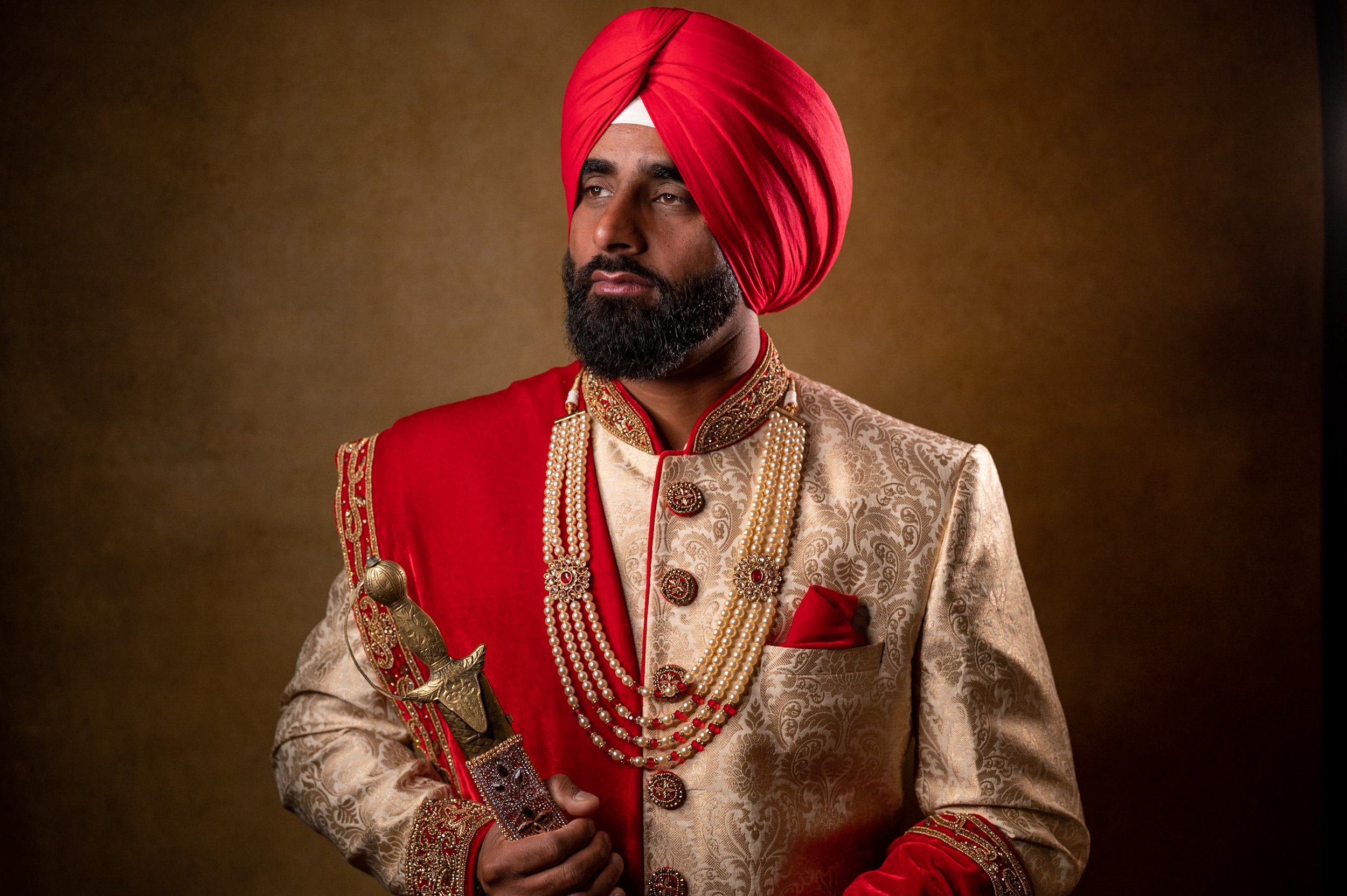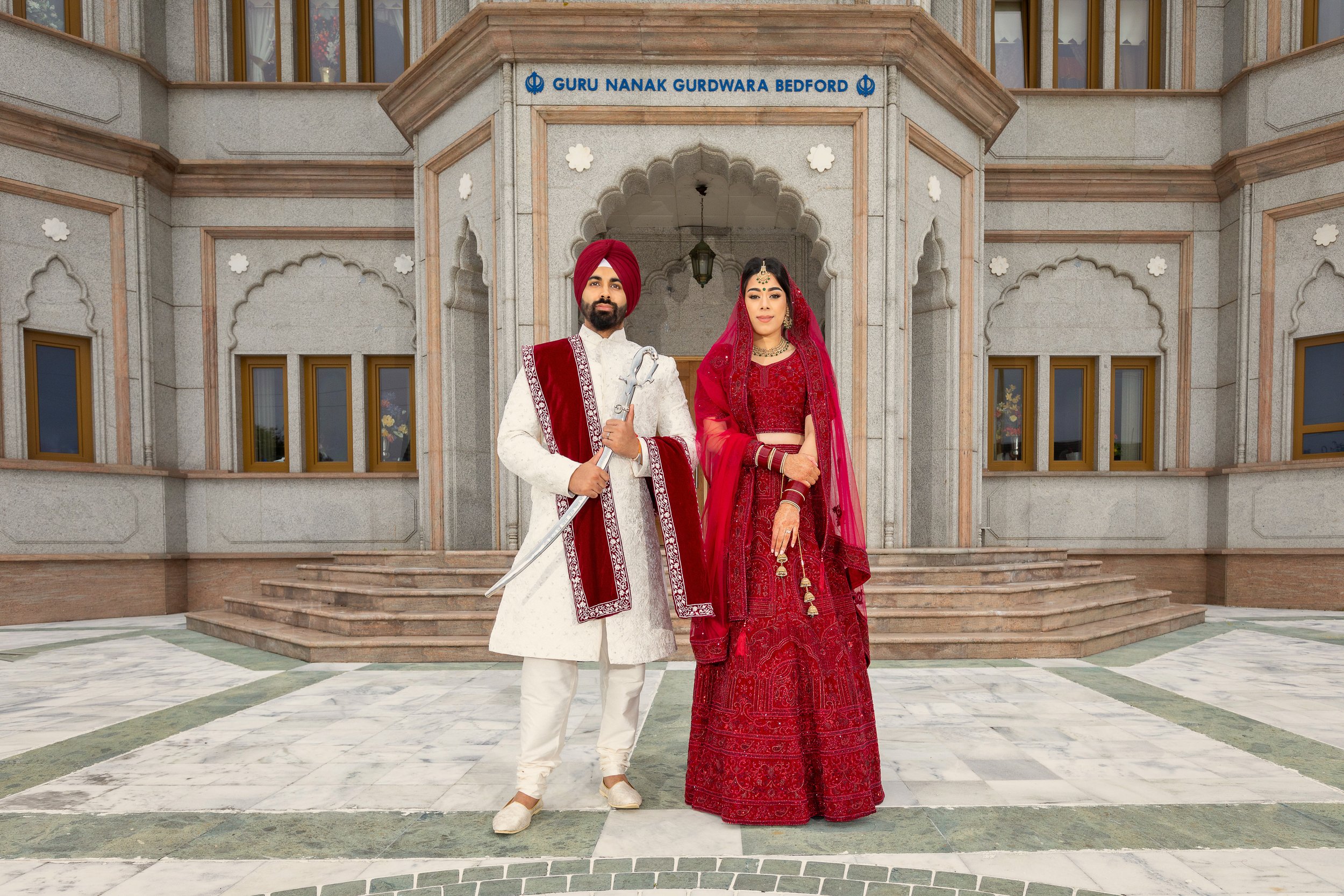Everything You Need to Know About Sikh Weddings
Sikh Weddings, often known as "Anand Karaj," which translates to "Blissful Union," are a remarkable display of Sikh culture, spirituality, and love. These weddings are not just the union of two souls but a celebration that reflects the rich heritage of the Sikh community. In this article, we will take you on a journey through the heart warming and elaborate rituals that make these Weddings a unique and cherished experience.
The Significance of Sikh Marriages
Punjabi Weddings hold a special place in the hearts of those who celebrate them. They are not only a union of two individuals but also a union of two souls in the presence of the Guru Granth Sahib (the holy scripture of Sikhism). The ceremony symbolises a commitment to a life of shared values, love, and spirituality. The essence of traditional Weddings lies in the belief that love and faith are the cornerstones of a happy marriage.
Wedding Attire
Bride's Attire
The bride's attire in a Wedding is nothing short of breath-taking. It's a visual symphony of tradition and modern elegance. At the heart of this ensemble is the bride's lehenga, a mesmerising garment that captures the essence of the occasion. Typically, it is adorned in traditional red or maroon, a choice of colour that signifies prosperity and love. This lehenga, however, is no ordinary dress; it's a masterpiece that often leaves onlookers in awe.
The intricate designs adorning the lehenga are a testament to the craftsmanship and artistry that go into its creation. Embroidered with meticulous care, the patterns tell a story of heritage and a deep connection to one's roots. From delicate floral motifs to more intricate geometric patterns, the lehenga represents not just the bride's attire but also her connection to the rich cultural tapestry of Sikh traditions.
But what truly sets the Sikh bride apart is the Chunni, a piece of cloth that covers her head. It serves not only as a symbol of modesty but also as a beautiful metaphor for the union of two souls. The Chunni is tied to the groom's scarf, signifying the inseparable bond that marriage creates. It's a moment of profound significance in the ceremony, where two individuals become one, and the Chunni embodies this union in a tangible and symbolic way.
In addition to the lehenga and the Chunni, the bride's attire is further enhanced by her jewellery. The chooda, a set of ivory or cream-colored bangles, is an essential part of her adornment. These bangles, traditionally gifted by her maternal uncle, represent purity and new beginnings. Wearing the chooda signifies the bride's transition into her new life as a married woman.
Another significant component of the bride's ensemble is the kalire, ornamental accessories that hang from her bangles. These intricate ornaments symbolise joy and good wishes for the bride's future. In a heartfelt ceremony, the bride's sisters and friends tie the kalire to her bangles, symbolising the hope for her happiness and prosperity in her married life.
The bride, adorned in her exquisite lehenga, Chunni, chooda, and kalire, is a picture of resplendent beauty. Her attire is a reflection of not just her personal style but also the deep-rooted traditions and customs that define Weddings. It is a visual celebration of love and commitment, a testimony to the timeless rituals that make weddings so unique and cherished.
In every stitch and in every piece of jewellery, the bride carries with her the legacy of generations, a commitment to her partner, and the promise of a future filled with love, understanding, and happiness. The Sikh bride's attire is not merely clothing; it's a living testament to the profound beauty of Weddings.
Groom's Attire
While the bride's attire in a Sikh Wedding is a vision of beauty and tradition, the groom's attire is a display of regal elegance and timeless style. As he stands beside his bride, the Sikh groom exudes a sense of grandeur and grace that perfectly complements the momentous occasion.
At the heart of the groom's ensemble is the traditional Sherwani, a garment that epitomises sophistication and grace. This long coat, often in shades of gold or cream, exudes a sense of regality that befits the significance of the occasion. The choice of colour symbolises purity, love, and prosperity, adding a layer of cultural and spiritual significance to the attire.
The Sherwani itself is a work of art, often intricately embroidered with exquisite patterns and motifs. These designs are a tribute to the rich heritage of Sikh culture and serve as a visual connection to the past. Whether adorned with floral patterns, geometric shapes, or other intricate detailing, the Sherwani is a symbol of the groom's appreciation for tradition and craftsmanship.
The groom's turban, known as the safa, is another integral part of his attire. Tied with precision and care, the safa not only adds to the groom's regal appearance but also holds profound cultural significance. It is often adorned with a kalgi, a brooch or ornament that symbolises the groom's commitment to his responsibilities as a husband and protector. The kalgi is a statement of honour, representing the groom's dedication to his bride and the new journey they are embarking upon together.
The kirpan, a ceremonial sword, is yet another iconic element of the Sikh groom's attire. It is a symbol of valour and responsibility. Worn by the groom, the kirpan signifies his readiness to protect and support his bride, his family, and his community. While it may seem unconventional to some, it holds deep spiritual and cultural meaning in Sikh tradition.
The Sikh groom's attire is more than just clothing; it is a manifestation of his reverence for tradition, culture, and love. Every detail, from the Sherwani to the safa, the kalgi to the kirpan, is a reflection of his commitment and dedication to his bride and the enduring customs of Weddings.
In his elegant attire, the groom stands as a symbol of strength, honour, and the promise of a harmonious and loving future with his bride. The Sikh groom's attire embodies the essence of Sikh or Punjabi weddings: a beautiful union of love, culture, and tradition. It is a visual testament to the profound significance of these joyous celebrations.
Wedding Customs in Sikh
Milni: A Joyous Union
The Sikh or Punjabi Wedding celebration commences with the Milni, a heart warming and joyous moment. During this custom, both families come together, and the male members exchange garlands and gifts. The atmosphere is filled with laughter and camaraderie as relatives and friends share in the happiness of the occasion. The Milni signifies the coming together of two families, with the hope of shared love, respect, and togetherness.
Anand Karaj: The Blissful Union
The heart of a Sikh or Punjabi Wedding lies in the Anand Karaj ceremony, which translates to "Blissful Union." This ceremony takes place in the Gurudwara, the sacred place of worship for Sikhs. The bride and groom, dressed in their resplendent attire, encircle the Guru Granth Sahib, the holy scripture of Sikhism, four times. Each circumambulation represents a commitment to one of the four virtues: Truth, Compassion, Contentment, and Humility.
The Anand Karaj is a profound and deeply spiritual ceremony. It is not just a union of two individuals but also a union of two souls in the presence of the divine. As the sacred hymns are recited, the couple's love and commitment are reinforced, and the entire congregation is filled with a sense of reverence and joy.
Laava: The Fourfold Blessings
The Laava are a significant part of the Anand Karaj, comprising four hymns that play a central role in Sikh customs. These hymns represent the four stages of a fulfilling life and emphasise the importance of love, harmony, and commitment in marriage. As each Laava is sung, the couple takes another step forward in their journey of love and unity.
Ardaas: Seeking Blessings
Following the Anand Karaj, an Ardaas, or a collective prayer, is performed. It is a heartfelt moment when the congregation comes together to seek blessings for the newlyweds. The Ardaas is a spiritual invocation for a harmonious and prosperous life for the married couple. It reinforces the belief that love, faith, and community are the cornerstones of a fulfilling marriage.
Langar: A Feast of Equality
Every Wedding is followed by a langar, a community feast. This tradition is a beautiful embodiment of Sikh principles of equality and unity. In the langar, all guests, regardless of their social or economic background, sit together and partake in a delicious meal. It is a powerful symbol of community and togetherness, signifying that all are equal in the eyes of the Guru.
Wedding customs are a celebration of love and tradition, where every ritual is a testimony to the enduring values of Sikh culture. They are a reminder that a wedding is not just a union of two individuals but a union of hearts, souls, and communities. These customs, rich in symbolism and spirituality, make Weddings a unique and cherished experience, where the essence of love and tradition is celebrated with immense joy and devotion.
Post-Wedding Traditions
Sadaa Suhagan After the wedding ceremony, a beautiful tradition follows called "Sadaa Suhagan." During this custom, the bride changes into an outfit presented to her by the groom's family and adorns herself with jewellery gifted by them. The elders of the family bless her with monetary gifts and offer their heartfelt wishes for her to forever remain a blessed and married woman, never experiencing widowhood.
Reception In celebration of the newly-wed couple, the groom's family hosts a grand reception party. Family and friends are warmly invited to partake in this joyous occasion. They come together to enjoy an extravagant meal and engage in a celebration filled with music, singing, and dancing.
Doli The Doli tradition holds a special place in weddings. Historically, a doli is a wooden palanquin used to transport women on their journeys. During the Doli ceremony, the bride bids farewell to her paternal home. As a symbol of her best wishes for her parents' eternal prosperity, she throws rice grains over her shoulders into her mother's outstretched hands. Friends and family gather to say their final goodbyes, and with their blessings, the bride embarks on her journey to her new home.
Upon her arrival at the groom's house, the bride is welcomed with warmth and affection by her new family. She is adorned with flowers, offered sweet treats, and showered with blessings, marking the beginning of her new life with love and acceptance.
Punjabi/Sikh Weddings: FAQs
What is the significance of the "Chunni" in a Sikh bride's attire? The Chunni is a symbol of the bride's modesty and her commitment to her husband. It is also a representation of the bride's acceptance of the groom as her protector.
Can non-Sikhs attend Weddings? Absolutely. Weddings are open to people of all faiths and backgrounds. They are a wonderful opportunity to experience Sikh culture and traditions.
Why are Weddings held in Gurudwaras? Gurudwaras are considered the holiest places in Sikhism. Holding the wedding in a Gurudwara signifies the couple's commitment to their faith and values.
What is the significance of the four circumambulations during the Anand Karaj? Each circumambulation represents the couple's commitment to the four virtues of Sikhism: Truth, Compassion, Contentment, and Humility.
Is the langar a mandatory part of Weddings? Yes, the langar is an essential part of a Wedding. It represents equality and community spirit, and all guests are invited to partake in the meal.
What should I wear to a Wedding? It's advisable to wear modest and respectful attire. Men can wear formal suits, while women should wear traditional or modest dresses.
Why do Sikh brides wear a red or maroon lehenga during their wedding? The choice of red or maroon is traditional and symbolises prosperity and love. These colours are considered auspicious and are often worn to reflect the festive and celebratory nature of the occasion.
What is the significance of the "Chunni" in a Sikh bride's attire? The Chunni is a symbol of modesty and represents the bride's acceptance of the groom as her protector. It is also tied to the groom's scarf, symbolising their union.
Are weddings followed by a particular set of post-wedding rituals? Yes, weddings are followed by post-wedding rituals that include the Sadaa Suhagan ceremony, a grand reception, and the Doli ceremony. These traditions are a blend of cultural customs and symbolise blessings and well-wishes for the newlyweds.
What is the significance of the kirpan in the groom's attire during a wedding? The kirpan, a ceremonial sword, represents valour and responsibility. Its presence symbolises the groom's readiness to protect and support his bride and family as they embark on their journey together.
Is there a particular dress code for guests attending a wedding ceremony? It's advisable for guests to dress modestly and respectfully. Men often wear formal suits, while women can opt for traditional or modest dresses out of respect for the sacred nature of the ceremony.
Why are weddings typically held in Gurudwaras? Gurudwaras are considered the holiest places in Sikhism, making them the ideal location for a wedding. It symbolises the couple's commitment to their faith and values.
Conclusion
Sikh Weddings are a remarkable celebration of love, culture, and spirituality. These weddings are a testament to the enduring traditions of Sikhism and the commitment of the couple to a life filled with love and harmony. The rich customs, resplendent attire, and deep spirituality make Wedding a unique and cherished experience for all who attend.
Wedding Photography
As experts in wedding photography, we have the privilege of immortalising the subtle traditional rituals that form the very heart of these ceremonies. Our profound understanding of the cultural significance allows us to craft images that are not just photographs but precious memories for the bride and groom. If you're interested in having us document your special day, please don't hesitate to get in touch by contacting Kishen below.
Client testimonials:
“If you want a stress free experience for your big day, then you should definitely book Kishen!”
If you want a stress free experience for your big day, then you should definitely book Kishen!
Kishen is knowledgeable and outstanding for photography. He goes above and beyond to make your event joyful and memorable. He’s definitely one of the best in the business, I am glad I booked him for our wedding (pre-wedding shoot, civil ceremony, reception and traditional Hindu wedding). Thank you all for your hard work and a special shout out for his wife, Shanti, for her guidance throughout the events and for being you!
Everybody complemented your work and your professionalism. Wish you all the very best!
Roshni & Vineet
“Kishen’s become part of our family, he knew exactly what we wanted.”
Kishen has been an absolute star throughout our journey! He knew exactly what we wanted and delivered beyond our expectation. Communication has been excellent throughout. Kishen and his wife, gave us directions as well as understanding what we wanted. Honestly it feels like he’s become part of our family more than just a client and that's what you need when your looking for a photographer. highly recommended if you need a photographer. We for sure will definitely use him for any future events and recommend him to our extended families!
Nik & Sapna
“Kishen is the photographer you want for your big day!”
Kishen was personable, very professional, and honestly he became part of the best day of my life in that he really captured beyond the classic wedding shots the entire day and everyone in my family and friends who were there to enjoy it with us. He also made me feel so calm, confident and comfortable as a bride. I am so grateful for his sincerity, his artistic and creative approaches and above that I was lucky to be referred him by my sister - on this note, without reservation, Kishen is the photographer you want for your big day!
Sam & Fahema
Messages are usually responded to within 24 hours.
If you haven't heard back by then, please check your junk mail folder, as email replies are sometimes sent there by mistake. Alternatively, leave your phone number so I can confirm receipt of your message and notify you that an email response has been sent.
photos by KISHEN | ASIAN WEDDING PHOTOGRAPHER LONDON | WEDDING PHOTOGRAPHERS NEAR ME | WEDDING PHOTOGRAPHER IN LONDON | LONDON WEDDING PHOTOGRAPHERS | ASIAN WEDDING PHOTOGRAPHER IN HARROW | ASIAN WEDDING PHOTOGRAPHER IN WATFORD | Asian Wedding Photography | Indian Wedding Photography | Indian Wedding Photographer | Hindu Wedding Photographer | LUXURY Wedding Photography | Punjabi Wedding Photography | Tamil Wedding Photographer | DESTINATION WEDDING PHOTOGRAPHER
photos by KISHEN
Award winning London Wedding Photographer
info@photosbykishen.co.uk
Tel: 07766 862233












